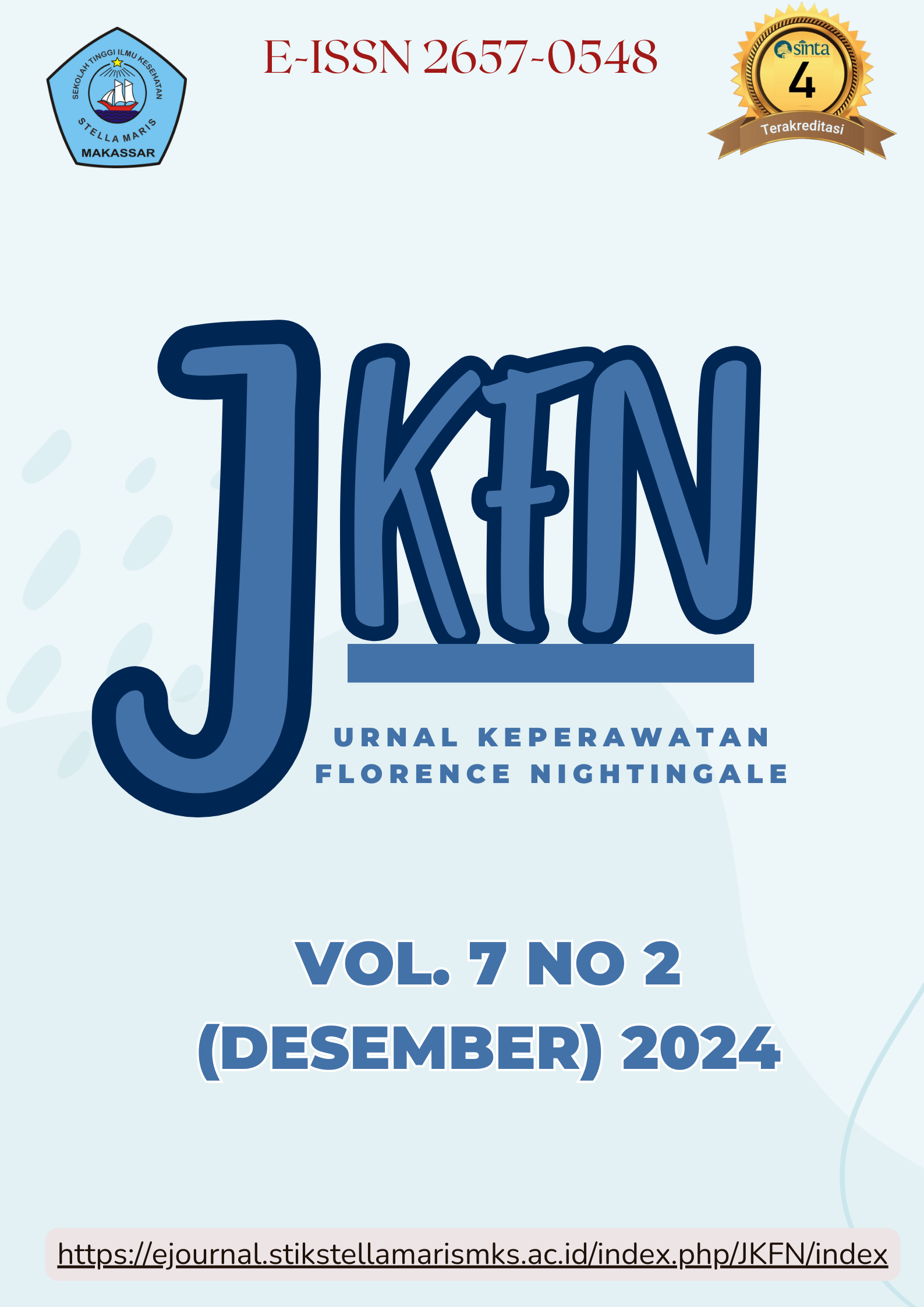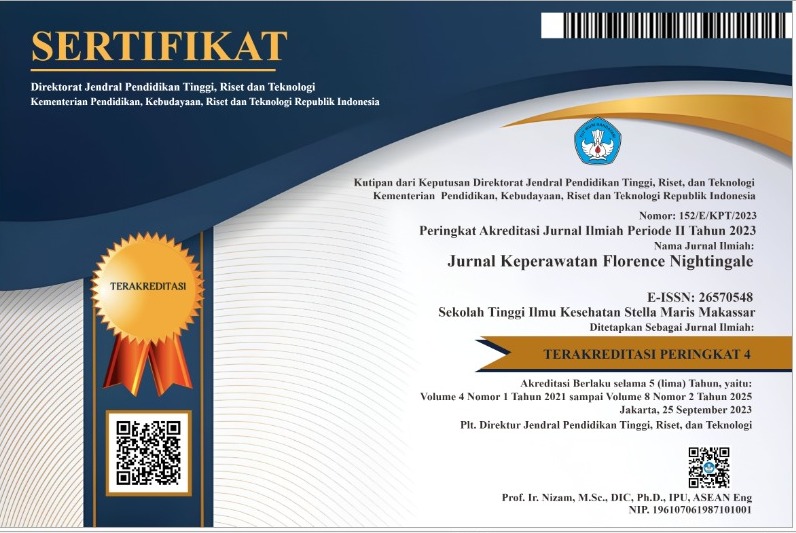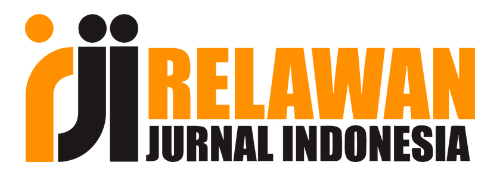Application of Colcaba Model Theory in Fulfilling Comfort Needs in Neonates with Duodenal Atresia
Keywords:
Colcaba, neonates, atresia duodenumAbstract
This research aims to analyze the application of Kolcaba Model Theory in meeting the needs of comfort in neonates with duodenal atresia. This research is a qualitative research with a case study approach on two neonates treated in the neonatal intensive care unit (NICU). Data were collected through direct observation, in-depth interviews with nurses and parents, and analysis of medical documents of two neonates as samples. The results showed that neonates' physical comfort was partially achieved with stable body temperature, although there were still problems with vital signs and skin condition, which required improvement in pain management and skin care. Environmental comfort was successfully maintained by keeping the baby's body temperature stable, although there were challenges in the room temperature which tended to be cold. These findings emphasize that nursing interventions based on Kolcaba Model Theory need to focus on improving pain management and skin care for physical comfort. The implementation of Kolcaba Model Theory in the care of neonates with duodenal atresia can improve the quality of nursing care in the NICU.
Downloads
References
Al-jahdali, F., Alsania, M. A., Almagushi, A. A., Alsaqqat, M. T., & Alnamshan, M. K. (2019). Risk Factors and Short Outcome of Bowel Atresia in Neonates at Tertiary Hospital. African Journal of Pediatric Surgery, 15(65), 108–110. https://doi.org/10.4103/ajps.AJPS
Ali, H. M. A. (2023). Effectiveness of Comfort Theory Model Based on Holistic Care for Hospitalized Children with Sickle Cell Disease Crises Effectiveness of Comfort Theory Model Based on Holistic Care for Hospitalized Children with Sickle Cell Disease Crises. Journal of Benha University, 1(1), 1–15.
Alshehri, A. (2024). Congenital Duodenal Obstruction: Atresia, Stenosis, and Annular Pancreas. In J. Camilleri-Brennan (Ed.), Current Concepts and Controversies in Laparoscopic Surgery. IntechOpen. https://doi.org/10.5772/intechopen.111385
Astuty, Y., & Nursanti, I. (2024). Model Konsep Teori Keperawatan Katherine Kolcaba. Jurnal Ilmu Keperawatan Dan Kebidanan, 2(2), 39–46.
Bagli, E., & Kucukoglu, S. (2020). Comfort in Premature Babies. Padiatri Kongresi, 3(3), 85–89.
Belal, A. A. A. E. S., Sabaq, A. G., & El-Ghany, W. A. (2023). Nurses Knowledge & Practices Regarding Hypothermia for Pretern Infants. Journal of Nursing Science, 4(2), 137–151.
Cuddapah, S. (2022). Probiotic Supplementation for Neonates with Congenital Gastrointestinal Surgical Conditions. The University of Western Australia.
Damayanti, Y., Sutini, T., & Sulaeman, S. (2019). Swaddling dan Kangaroo Mother Care Dapat Mempertahankan Suhu Tubuh Bayi Berat Lahir Rendah (BBLR). Journal of Telenursing (JOTING), 1(2), 376–385.
Deguchi, K., Tazuke, Y., Matsuura, R., Nomura, M., & Yamanaka, H. (2022). Factors Associated With Adverse Outcomes Following Duodenal Atresia Surgery in Neonates: A Retrospective Study. Cureus, 14(2), 1–14. https://doi.org/10.7759/cureus.22349
Egger-rainer, A., Trinka, E., Hö, J., & Maria, A. (2018). Epilepsy & Behavior Epilepsy monitoring–The patients’ views A qualitative study based on Kolcaba’s Comfort Theory. Elsevier: Epilepsy & Behavior, 1(1), 1–8. https://doi.org/10.1016/j.yebeh.2016.11.005
Hidayanti, D., & Woyka, S. (2024). Anesthesia management on Neonatal Atresia Duodenum With Gastric Ooutlet Obstruction: Case Report. Jurnal Ners, 8(2), 1145–1150.
Immawati, Nurhaeni, N., & Wanda, D. (2019). Case Study: the Application the Colcaba Theory on Measurement of Tempral Arterial Termometers. Jurnal Wacana Kesehatan, 4(2), 1–10.
Ingrit, B. L. (2019). The Application o f Levine’s a nd Kolcaba’s Theories in the Nursing Care of Patients with the Third Stadium of Cervical Cancer. Indonesian Journal of Nursing Practices, 3(2), 75–81.
Iswanti, E. N., & Masitoh, I. I. (2014). Hubungan Berat Badan Lahir Dengan Gangguan Sistem Termoregulasi Pada Neonatus di Ruang Perinatologi RSUD Dr. Hi. Abdul Moeloek Provinsi Lampung. Jurnal Kesehatan Holistik, 8(3), 126–130.
Kozlov, Y., Bokova, E., & Poloyan, S. (2024). Deodenal Atresia. IntechOpen, 1(1), 1–23.
Lei, L. (2023). Studies Neonatal Hypothermia: Understanding the Dangers and Importance of Temperature Control in Newborns. Journal of Neonatal Studies, 6(1), 85–87. https://doi.org/10.37532/jns.2023.6(3).85-87
Linardi, J. I., Dewi, M. R., & Linardi, J. I. (2021). Pendarahan Akibat Defisiensi Vitamin K Pada Neonatus: Sebuah Laporan Kasus. Jurnal Medicina, 52(3), 129–132. https://doi.org/10.15562/medicina.v52i3.1075
Manurung, M. E. M., Siregar, H. K., Sinaga, R. R., & Dewi, S. U. (2023). Keperawatan Holistik. Yayasan Kita Menulis.
Nada, D. E., & Nursanti, I. (2024). Application of Katherine Kolcaba’s Theory to Nursing Cases. Nusantara Hasana Journal, 3(8), 95–107.
Özdel, D., & Sari, H. Y. (2019). Effects of the prone position and kangaroo care on gastric residual volume, vital signs and comfort in preterm infants. Japan Journal of Nursing Science, 1(1), 1–8. https://doi.org/10.1111/jjns.12287
Pomalango, Z. B. (2023). Penerapan Teori Keperawatan Comfort Katharine Kolcaba dalam Pemberian Asuhan Keperawatan Perioperatif. Jurnal Anestesi, 1(3), 118–127
Ponte, K. M. de A., & Silva, L. (2015). Comfort as a result of nursing care: an integrative review. Journal of Research Fundamental Care Onlline, 7(2), 2603–2614. https://doi.org/10.9789/2175-5361.2015.v7i2.2603-2614
Rahmawati, V. Y., & Afiyanti, Y. (2022). Aplikasi Teori Keperawatan Wiedenbach dan Kolcaba. Jurnal Kesehatan Holistic, 6(1), 12–26.
Rustam, J. S., Kongsuwan, W., & Kitrungrote, L. (2021). Effects of nursing comfort care integrating with the daily Islamic rituals on comfort among mechanically ventilated Muslim patients: A randomized clinical trial. Nursing Practice Today, 8(4), 322–332.
Simamora, D. L. (2015). Hubungan Pemberian Bidan Terhadap Pemberian Vitamin K Pada Bayi Baru Lahir Dengan Sikap Bidan Dalam Pencegahan Defisiensi Vitamin K Pada Bayi Baru Lahir Kecamatan Pancur Batu. 1(1), 8–12.
Studer, A. (2020). Reducing Intraoperative Hypothermia in Infants from the Neonatal Intensive Care Unit. Infividual QI Project Form Signle Institutions, 8(4), 1–8. https://doi.org/10.1097/pq9.0000000000000665
Sugiharto, A., Herawati, I., Astuti, M. A., Purnamawati, I. D., Ruku, D. M., Natashia, D., & Galleryzki, A. R. (2023). Pengantar Dasar Fisiologis Untuk Praktik Keperawatan. Penerbit Yayasan Kita Menulis.
Sukamti, S., & Riono, P. (2019). Pelayanan Kesehatan Neonatal. Jurnal Teknologi Kesehatan, 2(2), 82–89.
Thewidya, A., Kurniyanta, P., & Wiryana, M. (2018). Manajemen termoregulasi untuk mencegah kejadian hipotermia pada pasien neonatus yang menjalani operasi gastroschisis. Jurnal Medicina, 49(2), 155–160. https://doi.org/10.15562/medi.v49i2.65
Uki, E., Nurhaeni, N., & Wanda, D. (2024). Application of Colcaba Comfort Theory in Children With Respiratory Disorders in the Infection Room: Case Study. Jurnal Ilmiah Kesehatan Pencerah, 13(2), 30–42.
UNDIP. (2021). Bayi Kelainan Kongenital Atresia Duodenum Berhasil Ditangani Oleh Tim Dokter Rumah Sakit Nasional Diponegoro Undip. https://www.undip.ac.id/post/22045/bayi-kelainan-kongenital-atresia-duodenum-berhasil-ditangani-oleh-tim-dokter-rumah-sakit-nasional-diponegoro-undip.html
irastri, U., Nurhaeni, N., & Syahreni, E. (2020). Aplikasi Teori Comfort Kolcaba Dalam Asuhan Keperawatan Pada Anak Dengan Demam di Ruang Infeksi Anak RSUPN Dr. Cipto Mangunkusumo. Jurnal Fakultas Ilmu Keperawatan Universitas Indonesia, 1(1), 27–32.
Yeni, R. I. (2017). Application of Kathrine Kolcaba’s Comfort Theory on Children Fulfillment of Oxygenation Need in Treatment Rooms. Ejurnal Umm, 8(1), 65–73.
Zendrato, M. L., & Permaida. (2023). Impact of Dance Therapy on Comfort Based on Kolcaba ’ s Nursing Theory in Children with Cerebral Palsy. The Malaysian Journal of Nursing, 15(1), 187–196. https://doi.org/10.31674/mjn.2023.v15i01.020
Published
How to Cite
Issue
Section
Copyright (c) 2025 Nurhayati, Sarah Rahmania, Dayang Laily, Dian Anggur Yulianti, Nyimas Heny Purwati

This work is licensed under a Creative Commons Attribution-ShareAlike 4.0 International License.









